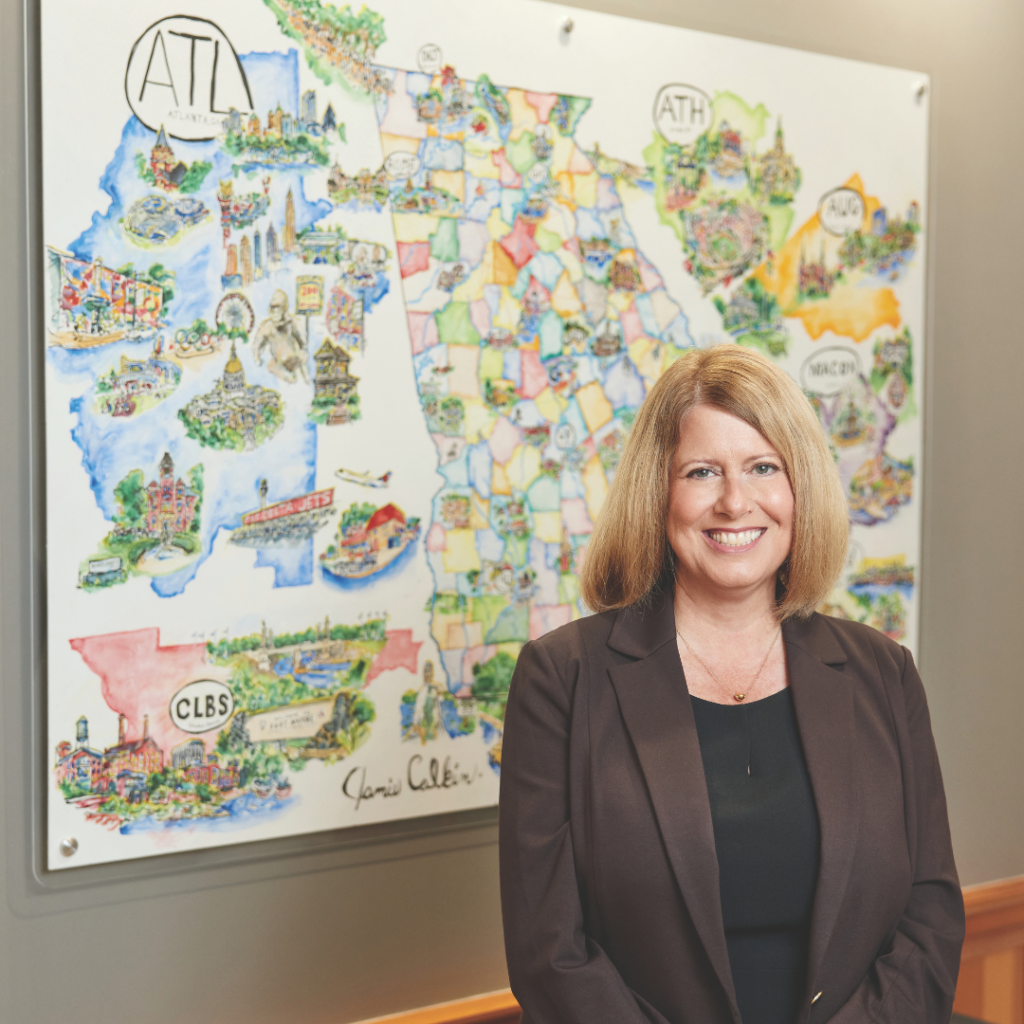Buckhead, Perimeter & True North 400 CIDs | Improving Quality of Life
Collaborating to make the region more attractive to residents and businesses.
Building and improving roads has long been a top priority in the dense office markets of northern Metro Atlanta. In recent years, there has been a shift. Today, governments are putting more resources into multiuse trails and pedestrian-friendly streets that enable people to get around without driving, as are community improvement districts (CIDs).
CIDs are districts in which businesses and property owners voluntarily tax themselves to pay for a wide variety of projects. Dollars are appropriated for projects ranging from road construction and landscaping to transit services and public art. The CIDs often collaborate with government agencies and other organizations to make projects happen faster.
One project generating a lot of buzz is PATH400. It is a priority for both the Buckhead CID and Perimeter CIDs, which are made up of the Fulton Perimeter CID in Sandy Springs and the Central DeKalb Perimeter CID, located partially in Dunwoody and partially in Brookhaven. PATH400 is a 5.2-mile biking and pedestrian greenway that winds along Georgia 400 and will eventually stretch all the way from the Atlanta Beltline up through Buckhead and Sandy Springs. The 10-to-14-foot-wide multiuse trail will provide a connection to neighborhoods, retail and office parks and give residents and visitors a new and safe way to move around the area.

Generating Buzz: PATH400 is a 5.2-mile greenway that runs parallel to Georgia 400 and will eventually stretch from the Atlanta Beltline to Sandy Springs. Photo Credit: Livable Buckhead
PATH400 is led by Livable Buckhead, in partnership with the Buckhead CID and the PATH Foundation. Several other agencies like the Georgia Department of Transportation, the city of Atlanta, MARTA, Atlanta Neighborhood Planning Unit B and Trees Atlanta are also involved.
“All these local governments and organizations are working together with the goal of connecting these big suburban markets to the inner core of downtown Atlanta,” says Ann Hanlon, executive director of the Perimeter CIDs. “Ultimately, we want to be able to say one day that people are able to walk from the Perimeter market to the Beltline.”
Hanlon says the COVID-19 pandemic prompted a new way of thinking about how transportation resources should be deployed.
“We have a very heavy focus on connecting our trail system,” she says. “We certainly see that after [the pandemic] people want to be outside. They want to live and work in areas where they can safely walk and where they can have access between their job and where they live [by being close to] transit stations.”
Creating Walkability
Connecting to amenities is critical to the success of modern office properties, and that has become a priority for CIDs, which also serve as a focal point for identifying and acting on changes in the economy that call for new approaches to transportation.

High-Quality Environment: Campus 244 is a mixed-use office project near the Dunwoody MARTA Station. Photo credit: Contributed
“The walkability [factor] is critical in today’s office environment,” says Phil Mays, Perimeter CIDs board member and principal at RocaPoint Partners, the developer of the Campus 244 mixed-use office project, at the site of the former Goldkist headquarters near the Dunwoody MARTA Station. “Office workers are looking for a high-quality environment so that they’re not feeling that work from home is a better option.”
Creating access to restaurants and shopping has become a selling point for properties in recruiting tenants and in turn for companies in recruiting and retaining talent.
“The suburban standalone office is dying, and so you don’t want to be in a situation where you’re not connected to various amenities around an individual office building,” Mays says.
Over the last decade, KDC, a developer of commercial office properties, has been building out Dunwoody’s massive Park Center campus. The fourth and last undeveloped portion of the campus was initially slated to be an office tower, but because of the impact from the pandemic, those plans were no longer viable, according to Jim George, development program manager with KDC.

Building Multifamily Housing: Jim George, development program manager with KDC, in front of the Park Center Campus. Photo credit: Joann Vitelli
The company was able to overcome the city’s long-standing reluctance to approve switching the site to mixed-use and residential. The prime factor driving the approval was a study on housing needs initiated by the Perimeter CIDs, he says.
“We were able to use it to get the zoning that we needed, and also it was a wakeup call for the city of Dunwoody that you can no longer turn your back to multifamily housing,” says George.
Surveys conducted by the Perimeter CIDs also reinforce that walkability is a priority for workers, according to Hanlon. Greenways and other walkable amenities are desirable, says Hanlon, who adds workers “want to have access to restaurants and shopping and entertainment, and they want trails nearby. So for our office building owners to say that’s an amenity that we have in our backyard is a huge differentiator in the office market.”
The trails and greenways also contribute to improved quality of life that businesses now prioritize.
“They’re the things that bind people together from a place of community, and that’s a great attractor to developers and businesses that want to be there,” says Leslie Day-Harrell, vice board chair at True North 400 CID and executive vice president of associate experience and head of corporate real estate at Jackson Healthcare. “It’s creating places and spaces for enjoyment, for beauty, for connecting with nature. So our job is to create better communities. And that is a piece that maybe we’ve overlooked in years past.”
The True North 400 CID has various projects focused on adding paths and greenways across North Fulton County, according to Deputy Executive Director Kristin Winzeler.

Emphasis on Placemaking: Kristin Winzeler, True North 400 deputy executive director, on the Big Creek Greenway near the future site of the Encore Greenway Park. Photo credit: Woodie Williams
“There’s a lot more emphasis on placemaking and getting people back in the office,” she says. “It’s great to create a new connection, but can we make that connection walkable? Where is it going? What is it connecting to for pedestrians, for bikes? Is there transit associated
with it?”
One of the CID’s biggest efforts is building the Encore Greenway Park and Gateway. Located at North Point Parkway and Encore Parkway, the project will create a connection to the Big Creek Greenway and the Alpha Loop – two of the area’s largest trail systems. Last year, the Alpharetta City Council approved a $9.1 million contract with Strack Inc. for the construction of the park. The CID board also voted to kick in $1.5 million for the project, according to Winzeler.
“The city of Alpharetta is partnering on that project with us,” she says. “We will be building a brand-new greenway connection, a brand-new gateway, as well as a little park that will feature that gateway.”
These efforts mark a change in perspective for the CID.
“It’s a really impressive project, but I don’t know that we would have been investing in that type of project two decades ago or even a decade ago, and now this is huge for us,” says Winzeler, who says road projects are also being upgraded to include lighting, landscaping and wider sidewalks to better accommodate pedestrians.

Impressive Project: Encore Greenway Park and Gateway, located at North Point Parkway and Encore Parkway, will connect the Alpha Loop to the Big Creek Greenway. Photo credit: Contributed
There is also a far-reaching economic development aspect to these projects. These trails will provide not only alternative means for moving around the area but boost local hotels and restaurants as well.
“Although it will connect where people live to jobs, it’s also a good amenity for leisure, and it helps with hospitality,” says Kathi Cook, Alpharetta’s director of community development. “People visiting Alpharetta for the week for work may stay an extra day to check out the multiuse trail system.”
The Dryden Road extension is a result of a partnership between the CID, Alpharetta and AT&T, according to Winzeler. The new roadway will extend Dryden Road from North Point Parkway to Edison Drive just south of Windward Parkway. The project will provide greater access to AT&T, tech company Flexential and The Edison, a 216,000-square-foot office campus.
Also under construction is the Kimball Bridge Road Corridor, a multimodal path along Kimball Bridge Road between North Point Parkway and Georgia 400.
Pedestrian-Friendly Roads
Even as trails grow in importance, improved roads and streets are still a top priority throughout the metro area. The Buckhead CID is putting considerable time and resources into improving connection and traffic flow.
“It’s all about creating a Buckhead core that better connects people and places,” says Jim Durrett, Buckhead CID executive director. “We do that by ensuring that people, no matter how they get around, find it easier and more pleasant to go places within the district.”

New and Improved: Upgraded sidewalks on Lenox Road will enhance the look of the area and make it easier for people to walk from one business to another. Photo credit: Contributed
A prime way of facilitating that movement is by making the district more walkable and bikeable, according to Durrett.
The Piedmont Road Complete Street project is widening the throughfare while creating more access for pedestrians and bikes. The road from Peachtree Road north to the Lenox Road intersection “is a stretch of road that has lanes appearing and disappearing and becoming different widths,” he says. “It’s a confusing stretch of road to drive. It’s also not a very inviting stretch of road to walk or to ride a bicycle on.”
In addition, the project will create a multiuse path on the west side of Piedmont Road “for people who would rather not drive an automobile or ride a bus to that corridor,” Durrett says.
This section of central Buckhead is home to high-rise office and multifamily developments including Terminus and Modera Prominence. The new path will connect another multiuse trail on Lenox Road as part of the PATH400 Greenway system.

Connecting People and Places: Jim Durrett, executive director of the Buckhead CID. Photo credit: Contributed
By the end of this year, Buckhead will also get one of the city of Atlanta’s first multilane roundabouts at Wieuca Road and Phipps Boulevard. The $4 million project is expected to ease traffic congestion while also reducing the number and severity of collisions at one of Buckhead’s busiest intersections.
Another big effort will make major improvements to Lenox Road and the surrounding areas, and it will be done in three sections. Section one focuses on pedestrian-friendly enhancements such as the Lenox Boardwalk, which includes a multiuse trail between the Lenox MARTA Station and Peachtree Road. This wide boardwalk will improve the look of the area and better connect businesses. Section two, from Peachtree Road to Phipps Boulevard, will include wider sidewalks with ramps, staircases and lighting, which will connect the many businesses in Buckhead’s commercial core.
A third section of the project will create an elevated pedestrian and bicycle bridge between Phipps Boulevard and Piedmont Road, at the Lenox Road and Georgia 400 Interchange. The bridge is expected to become the gateway to another planned amenity – HUB404. This half-mile green space above Georgia 400 will create a high-profile park above the highway. All three of these sections will be under construction this year, with the first expected to be complete in November.

Award-Winning Concept: Rendering of HUB404, which will create a green space above Georgia 400 in Buckhead. Photo credit: Contributed
All the Buckhead CID projects are made possible by funding from multiple sources – both private and public. The roundabout, for example, “was coordinated and made possible by a lot of CID money, but also city of Atlanta money,” says Thad Ellis, chair of the Buckhead CID board and a retired executive with Cousins Properties Inc.
Highways, Bridges and Shelters
The Perimeter CIDs will be ground zero for one of the biggest transportation projects in Georgia history.
The state selected SR 400 Peach Partners to construct new variable priced toll lanes along 16 miles of Georgia 400. The massive 400 Express Lanes project will add new express lanes in both directions from the North Springs MARTA station at exit 5C in Fulton County to one mile north of McFarland Parkway at Exit 12 in Forsyth County.
The I-285 Top End Express Lanes project is another effort aimed at speeding traffic flow for both commuters and trucks through Metro Atlanta. GDOT is adding two express lanes in both directions on Georgia 400 from south of the Glenridge Connector to near the North Springs MARTA Station.
All of this construction has presented the CIDs with an opportunity to enhance the appearance of the roads and connections within its borders, with a program to decorate bridges.
“We hope to tackle 11 bridge structures,” says Hanlon, who says the plan includes decorative stonework and lighting and the placement of benches. The goal is to ensure that these connections and pylons “will continue to have a distinctive look and feel,” she says, adding that recommendations for each bridge will be submitted to the Georgia Department of Transportation this spring.
Meanwhile, True North 400 is creating an improved experience for mass transit users with its MARTA Bus Shelter Program. The CID designed and helped fund five upgraded shelters in partnership with the city of Alpharetta.
“We have MARTA buses running to stops at large employers along different routes within the city, but a lot of these locations don’t have shelters,” says Alpharetta’s Cook, who says more shelters are expected at other large employers within the district.
Whether it’s helping build shelters and greenways or widening busy thoroughfares, the CIDs in North Metro Atlanta are leading the way to meet the changing needs of a rapidly growing region. 









